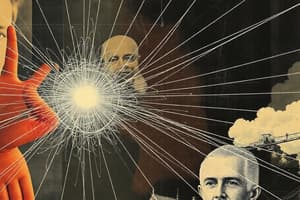Podcast
Questions and Answers
How is the electric force related to the distance and the interaction charges according to Coulomb's law?
How is the electric force related to the distance and the interaction charges according to Coulomb's law?
- No relation
- Inversely-Directly (correct)
- Directly-Inversely
- Directly-Directly
Coulomb's law applies specifically to which type of charge scenario?
Coulomb's law applies specifically to which type of charge scenario?
- Dynamic
- Static (correct)
- Accelerated
- Movable
What happens to electric flux when the number of electric field lines increase?
What happens to electric flux when the number of electric field lines increase?
- It fluctuates
- It remains constant
- It decreases
- It increases (correct)
What term describes the area around a charge where its effect is felt?
What term describes the area around a charge where its effect is felt?
If a 10 mC particle has an electric potential energy of 5 J, what is the electric potential at its destination?
If a 10 mC particle has an electric potential energy of 5 J, what is the electric potential at its destination?
What is the relationship between the forces exerted by two charged objects on each other?
What is the relationship between the forces exerted by two charged objects on each other?
If two-point charges initially 4.0 cm apart exert a force of 1.0 N, what will the new force be if they are moved to a separation of 1.0 cm?
If two-point charges initially 4.0 cm apart exert a force of 1.0 N, what will the new force be if they are moved to a separation of 1.0 cm?
How can the electric field intensity be calculated for a power line carrying 660 KV at a height of 30 meters?
How can the electric field intensity be calculated for a power line carrying 660 KV at a height of 30 meters?
Where can a third charge be placed on the x-axis for an initial configuration of +3.0 C at the origin and +9.0 C at x = 4.0 m to ensure net force equals zero?
Where can a third charge be placed on the x-axis for an initial configuration of +3.0 C at the origin and +9.0 C at x = 4.0 m to ensure net force equals zero?
What is the magnitude of the electric field at the midpoint between two +3 C charges that are separated by 4.0 m?
What is the magnitude of the electric field at the midpoint between two +3 C charges that are separated by 4.0 m?
What is the magnitude of the force on q2 (3.0 μC) located at x = 0 due to q1 (2.0 μC at x = 1.0 m) and q3 (-5.0 μC at x = -1.0 m)?
What is the magnitude of the force on q2 (3.0 μC) located at x = 0 due to q1 (2.0 μC at x = 1.0 m) and q3 (-5.0 μC at x = -1.0 m)?
Electric flux through a surface can be measured by which of the following metrics?
Electric flux through a surface can be measured by which of the following metrics?
What is the net electric flux through any closed surface according to Gauss's law?
What is the net electric flux through any closed surface according to Gauss's law?
Flashcards
Coulomb's Law relationship to distance & charges
Coulomb's Law relationship to distance & charges
The electric force between two charges is inversely proportional to the square of the distance between them and directly proportional to the product of the magnitudes of the charges.
Coulomb's Law application
Coulomb's Law application
Coulomb's law applies to static or stationary charges.
Electric flux increase
Electric flux increase
Increased electric field lines result in greater electric flux.
Electrical field definition
Electrical field definition
Signup and view all the flashcards
Electric Potential Energy to Potential
Electric Potential Energy to Potential
Signup and view all the flashcards
Force between charges
Force between charges
Signup and view all the flashcards
Force change with distance
Force change with distance
Signup and view all the flashcards
Electric field intensity calculation (power line)
Electric field intensity calculation (power line)
Signup and view all the flashcards
Third charge for zero net force
Third charge for zero net force
Signup and view all the flashcards
Electric field at midpoint
Electric field at midpoint
Signup and view all the flashcards
Force magnitude between 3 charges
Force magnitude between 3 charges
Signup and view all the flashcards
Electric flux measurement
Electric flux measurement
Signup and view all the flashcards
Net electric flux (Gauss's Law)
Net electric flux (Gauss's Law)
Signup and view all the flashcards
Study Notes
Coulomb's Law and Electric Force
- The magnitude of the force between two point charges is directly proportional to the product of the charges and inversely proportional to the square of the distance between them.
- Two charges exert forces on each other that are equal in magnitude and opposite in direction.
- If the distance between two charges is halved, the force between them increases fourfold.
Electric Field
- Electric field intensity is a measure of the strength of an electric field at a point.
- The electric field intensity under a power line is directly proportional to the voltage of the power line and inversely proportional to the distance from the power line.
- Electric flux is a measure of the number of electric field lines passing through a given surface.
- Gauss's law states that the net electric flux through any closed surface is proportional to the enclosed charge.
Electric Potential
- Electric potential energy represents the energy possessed by a charge due to its position in an electric field.
- Electric potential is the potential energy per unit charge.
- The unit of potential is Joules per Coulomb (J/C), which is also known as Volt (V).
Studying That Suits You
Use AI to generate personalized quizzes and flashcards to suit your learning preferences.




